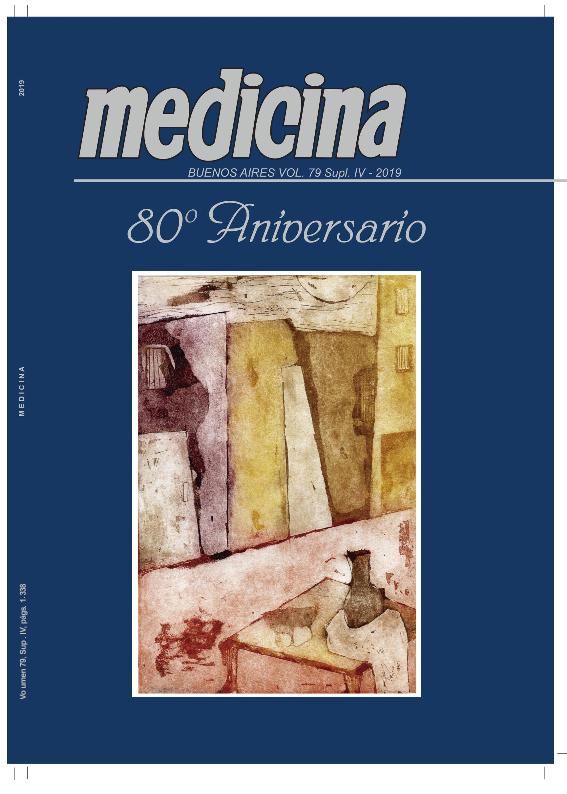Evento
Association between clinical and genetic diagnosis in patients with LQT syndrome: importance of genetic testing
Dionisio, Leonardo Raul ; Aztiria, Eugenio Manuel
; Aztiria, Eugenio Manuel ; Stupniki, Sofia
; Stupniki, Sofia ; Dye, Leandro; Onetto, Leonardo; Gregorietti, Franco; Keegan, Roberto; Spitzmaul, Guillermo Federico
; Dye, Leandro; Onetto, Leonardo; Gregorietti, Franco; Keegan, Roberto; Spitzmaul, Guillermo Federico
 ; Aztiria, Eugenio Manuel
; Aztiria, Eugenio Manuel ; Stupniki, Sofia
; Stupniki, Sofia ; Dye, Leandro; Onetto, Leonardo; Gregorietti, Franco; Keegan, Roberto; Spitzmaul, Guillermo Federico
; Dye, Leandro; Onetto, Leonardo; Gregorietti, Franco; Keegan, Roberto; Spitzmaul, Guillermo Federico
Tipo del evento:
Reunión
Nombre del evento:
LXIV Reunión Anual de la Sociedad Argentina de Investigación Clínica; LI Reunión Anual de la Asociación Argentina de Farmacología Experimenta; XXI Reunión Anual de la Sociedad Argentina de Biología; XXXI Reunión Anual de la Sociedad Argentina de Protozoología; IX Reunión Anual de la Asociación Argentina de Nanomedicinas y VI Reunión Científica Regional de la Asociación Argentina de Ciencia y Tecnología de Animales de Laboratorio
Fecha del evento:
13/11/2019
Institución Organizadora:
Sociedad Argentina de Investigación Clínica;
Asociación Argentina de Farmacología Experimental;
Sociedad Argentina de Biología;
Sociedad Argentina de Protozoología;
Asociación Argentina de Nanomedicinas;
Asociación Argentina de Ciencia y Tecnología de Animales de Laboratorio;
The Histochemical Society;
Título de la revista:
Medicina (Buenos Aires)
Editorial:
Fundación Revista Medicina
ISSN:
0025-7680
e-ISSN:
1669-9106
Idioma:
Inglés
Clasificación temática:
Resumen
Long QT syndrome (LQTS) is a congenital genetic disorder that cause cardiac arrhythmia and sudden death. The genes more frequently implicated are those encoding for the K+ channels KCNQ1 (40 - 45 %) and HERG (40 – 45 %), and the Na+ channel Nav1.5 (5 – 8 %). Dysfunction in these channels leads to QT interval lengthening in ECG. Molecular identification of the causes of this disease contributes to better diagnosis, risk stratification and pharmacological treatment improvement. Our aim is to correlate clinical diagnosis with genetic variants of LQTS. We examined the LQT-associated genes KCNQ1, KCNH2 and SCN5A using gDNA extracted from 6 subjects. Five of them showed a prolonged QT interval on the ECG (>460 ms) while 1 first-degree relative presented a normal QT interval (<450 ms). The group (3 males and 3 females, 0-62 years old) included 1 with sudden cardiac death history under 40 years old and 1 with presyncope and documented polymorphic ventricular tachycardia. We amplified all exons from the 3 genes by PCR followed by sequencing. For KCNQ1 we found the uncommon variant c.1638G>A (p.Ser546=) in 2 subjects. In 1 patient we could not amplify exon 16, suggesting exon deletion. For KCNH2 we found the following variants: c.1692A>G (p.Leu564=) in 1 patient, c.1956T>C (p.Tyr652=) in 5 out of 6 cases and c.2690A>C (p.Lys897Thr) in 1 patient. Finally, we found the likely-pathogenic variant c.982C>T (p.Arg328Cys). For SCN5A no variants were detected at the tested exons. We found benign and pathological genetic variants in either KCNQ1 or KCNH2 genes of our population. No information about the exon 16 deletion for KCNQ1 as a pathological variant has been reported. To our knowledge, this is the first genetic test of LQTS performed in Argentina. Genetic characterization will impact on patient habits, avoiding risk situations such as sports, acute stress or cardiotoxic drugs therapies. Moreover, these studies will enable to set patient-oriented pharmacological treatments.
Palabras clave:
ARRHYTMIA
,
LQTS
,
KCNQ1
,
MUTATION
Archivos asociados
Licencia
Identificadores
Colecciones
Eventos(INIBIBB)
Eventos de INST.DE INVEST.BIOQUIMICAS BAHIA BLANCA (I)
Eventos de INST.DE INVEST.BIOQUIMICAS BAHIA BLANCA (I)
Citación
Association between clinical and genetic diagnosis in patients with LQT syndrome: importance of genetic testing; LXIV Reunión Anual de la Sociedad Argentina de Investigación Clínica; LI Reunión Anual de la Asociación Argentina de Farmacología Experimenta; XXI Reunión Anual de la Sociedad Argentina de Biología; XXXI Reunión Anual de la Sociedad Argentina de Protozoología; IX Reunión Anual de la Asociación Argentina de Nanomedicinas y VI Reunión Científica Regional de la Asociación Argentina de Ciencia y Tecnología de Animales de Laboratorio; Mar del Plata; Argentina; 2019; 86-87
Compartir



